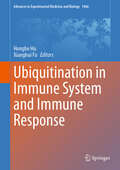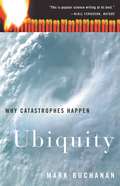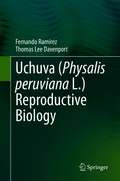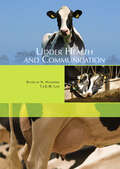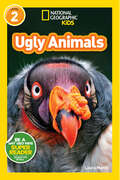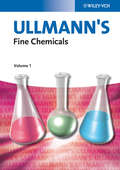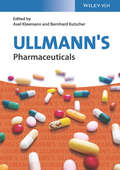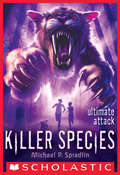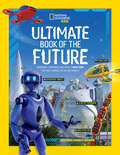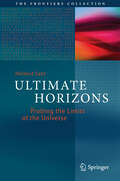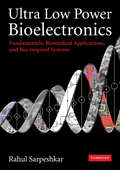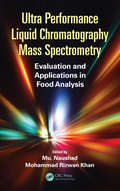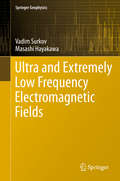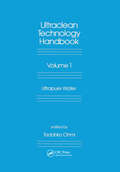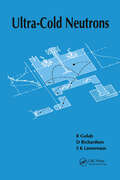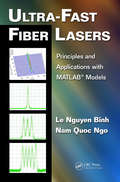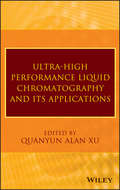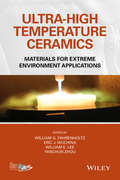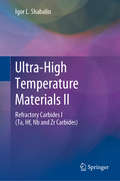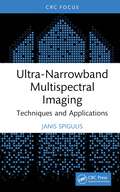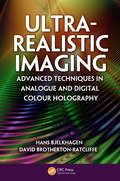- Table View
- List View
Ubiquitin-Proteasome Protocols
by Cam Patterson Douglas M. CyrA collection of cutting-edge techniques for studying ubiquitin-dependent protein degradation via the proteasome. The topics covered range broadly from basic biochemistry to cellular assays to discovery techniques using mass spectrometric analysis. These biochemical and cellular methods are necessary to explore the ubiquitin-proteasome system and ubiquitin-proteasome-dependent functions. State-of-the-art and user-friendly, Ubiquitin-Proteasome Protocols offers novice and experienced bench scientists alike a thorough compendium of readily reproducible techniques that will accelerate discovery, enhance productivity, and permit manipulation of the system for varied research purposes.
Ubiquitination in Immune System and Immune Response (Advances in Experimental Medicine and Biology #1466)
by Hongbo Hu Xianghui FuUbiquitination is a major protein post-translational modification, which is involved in many aspects of cellular procedure. The functions of ubiquitination in immune system and immune response have been intensively studied. This book aims to introduce the latest and crucial achievements, along with the fundamental principles of ubiquitination and immune responses. It covers the proteomic aspects of ubiquitination, the function of ubiquitin in innate and adoptive immunity, the development of immune cells, and the metabolism. The active researchers in this field are invited to contribute the chapters. This book is suitable for graduate students, researchers and readers who are interested in this field. It will provide readers with comprehensive insight into how ubiquitination functions in different aspects of immune system.
Ubiquity: Why Catastrophes Happen
by Mark BuchananScientists have recently discovered a new law of nature. Its footprints are virtually everywhere - in the spread of forest fires, mass extinctions, traffic jams, earthquakes, stock-market fluctuations, the rise and fall of nations, and even trends in fashion, music and art. Wherever we look, the world is modelled on a simple template: like a steep pile of sand, it is poised on the brink of instability, with avalanches - in events, ideas or whatever - following a universal pattern of change. This remarkable discovery heralds what Mark Buchanan calls the new science of 'ubiquity', a science whose secret lies in the stuff of the everyday world. Combining literary flair with scientific rigour, this book documents the coming revolution by telling the story of the researchers' exploration of the law, their ingenious work and unexpected insights. Mark Buchanan reveals how the principle of ubiquity will help us to manage, control and predict the future. This book, the world's first on the topic, will change how we think about the world and our place in it.
Uchuva (Physalis peruviana L.) Reproductive Biology
by Fernando Ramírez Thomas Lee DavenportThis work reviews and explores various aspects of uchuva growth and development from seed germination, vegetative growth and phyllotaxy, floral development, pollination, and pollen morphology through fruit development, properties and health benefits. Other sections of the book cover uchuva genetic diversity, hybridization, chromosome number and morphological diversity. Uchuva is economically important in most South American counties, has been growing in popularity in Central America, and is marketed in North American and Europe as the golden berry. This is the first concise reference work that delves into the fascinating world of uchuva reproductive biology. It includes the latest scientific references, some of which have been contributed by the authors of the current book. The authors have observed the plant in the field and have produced a unique photographic record to help the reader see the actual morphological structures and developmental processes in action.
Udder Health and Communication
by H. Hogeveen T.J.G.M. LamIn dairy industries throughout the world there is a desire to optimize udder health. An improved udder health will lead to improved animal welfare, improved production efficiency and a reduction of the use of antibiotics. To improve udder health, first of all, technical knowledge on issues such as treatment, milking, infectious pressure and host resistance is important. However, over the years we learned that knowledge alone is not enough: knowledge has to be used. And for knowledge to be used, farmers have to be motivated. This requires knowledge about motivation and communication. In this book, recent knowledge on technical udder health issues is combined with knowledge on motivation and communication. A large number of descriptions of mastitis control programs that are being carried out worldwide is combined with more specific studies. These are aimed at effective advising, motivation and communication strategies, economics, and technical studies on mastitis control and prevention. Therefore, this book provides an applied source of information for all that are willing to improve udder health.
Ufology: A Very Short Introduction
by Mark DorioUfology: Presents a serious survey of the study of UFOs and related phenomena, providing a good first step toward understanding this topic.
Ugly Animals (National Geographic Kids Readers)
by Laura MarshSometimes, the uglier, the better! In this level 2 reader, young readers will meet the ugliest of animals. Follow these funny-looking creatures and learn how their strange looks help them in the wild. Interesting photos and carefully leveled text make this book perfect for reading aloud or for independent reading.
Ullmann's Fine Chemicals
by UllmannA compilation of 76 articles from the ULLMANN's Encyclopedia of Industrial Chemistry, this three-volume handbook contains a wealth of information on the production and industrial use of more than 2,000 of the most important fine chemicals, from "Alcohols" to "Urea Derivatives". Chemical and physical characteristics, production processes and production figures, main uses, toxicology and safety information are all found here in one single resource. Order your copy now and benefit from the introductory offer! Introductory price, valid until 30 June 2014: US $575. 00 / £350. 00 / e429. 00 List price thereafter: US $675. 00 / £410. 00 / e499. 00
Ullmann's Pharmaceuticals
by Axel Kleemann Bernhard KutscherBased on the WHO's Anatomical Therapeutical Chemical drug classification system, virtually all marketed therapeutics are covered here in 46 topical and systematic articles. Each carefully selected section contains a general introduction to the therapeutic class, current developments and challenges, followed by a systematic listing of all important products. For each therapeutic, up-to-date information on compound structure, mechanism, pharmacology, clinical use, time on market, and production methods is provided, complete with references to the scientific and patent literature. With all articles either rewritten or completely updated to include marketed drugs up to 2021, this unique reference provides reliable data on more than 2,000 products, making it an indispensable guide for every professional in the pharmaceutical and medical sector.
Ultimate Attack: Ultimate Attack (Killer Species #4)
by Michael P. SpradlinThe action-packed series by Michael P. Spradlin returns. Each book covers a genetically engineered superpredator wreacking havoc on the environment.It's all come to this.Dr. Catalyst has had enough of Emmet Doyle's meddling. Time after time, Emmet and his friend Calvin Geaux have stepped in to ruin his plans, just when he'd released one of his genetically engineered killer species into the Florida environment.This time, Dr. Catalyst is releasing his most deadly creation yet. It's a terrifying lone hunter, bred to stalk and destroy one specific target -- Emmet Doyle.
Ultimate Book of the Future: Incredible, Ingenious, and Totally Real Tech that will Change Life as You Know It
by National Geographic KidsRobot dogs! Jet packs! Cyborgs! Super-sleek space suits! It's not science fiction, it's science reality. And soon, it may be part of everyday life. This book is a jam-packed collection of the coolest tech and wildest ideas that are shaping the world of tomorrow. Blast off for an unbelievably fascinating journey through time, space, and even a holographic pop concert (or two)! With chapters on future cities, space travel, high-tech entertainment, and even saving the world, Future World is a thorough, fun compendium of high-tech gadgets being built today and the coolest stuff tomorrow has to offer, plus the amazing dreamers making it all happen. Special "Could It Happen?" features tackle kids" burning hypothetical questions, like whether Jurassic Park could really exist, or whether a robot could become president. Each chapter also includes a "Future Fail!" that profiles one thing we thought we'd have by now, but don't (like everything from The Jetsons.) And kids will see where they might fit into the picture through the "Jobs of Tomorrow" profiled in each chapter. (Job titles include mind reader, space pilot, and robot-human communicator. Seriously!) This is the perfect book for fans of sci-fi, budding engineers and scientists, lovers of futuristic movies and pop culture, and anyone who has ever dreamed about what tomorrow might look like. With chapters on future cities, space travel, high-tech entertainment, animal-inspired tech, and even saving the world, this book is a thorough, smart, and—at times—even funny guide to life in the future. A fresh, futuristic design; big, exciting images; and chunky, digestible text make even the most complex-seeming tech and science accessible and fun. Plus, seven original, full-spread illustrations—reviewed by an expert futurist—will give kids a glimpse into the world of tomorrow.
Ultimate Explanations of the Universe
by Michael HellerWe humans are collectively driven by a powerful - yet not fully explained - instinct to understand. We would like to see everything established, proven, laid bare. The more important an issue, the more we desire to see it clarified, stripped of all secrets, all shades of gray. What could be more important than to understand the Universe and ourselves as a part of it? To find a window onto our origin and our destiny? This book examines how far our modern cosmological theories - with their sometimes audacious models, such as inflation, cyclic histories, quantum creation, parallel universes - can take us towards answering these questions. Can such theories lead us to ultimate truths, leaving nothing unexplained? Last, but not least, Heller addresses the thorny problem of why and whether we should expect to find theories with all-encompassing explicative power.
Ultimate Horizons
by Helmut SatzIn the last hundred years, modern physics and cosmology have shown that there exist regions of the universe forever beyond our reach, hidden by truly ultimate horizons. Such regions exist in those remote parts of the universe where, from our point of view, space expands faster than the speed of light. They are found in black holes, where the gravity is strong enough to retain even light within its field of attraction. And in the realm of the very small, quarks must remain forever confined to their world of extreme density and can never be removed from it. The aim of this book is to describe these ultimate horizons, how they were discovered, how they shape our view of the world, and what clues we have about a world beyond them.
Ultimate Showdown (Who Would Win?)
by Jerry Pallotta Robert BolsterWhat if one dangerous animal had a fight with another? Who do you think would win? In this five-book bind-up of the popular Who Would Win? series, kids will learn about each animal's anatomy, behavior, and more. Then compare and contrast the battling pairs before finally discovering the winner! This nonfiction collection is full of facts, photos, and realistic illustrations, and it includes a range of mammals, sea creatures, insects, and dinosaurs to satisfy all kinds of animal fans, including Lion vs. Tiger, Hammerhead vs. Bull Shark, Polar Bear vs. Grizzly Bear, Hornet vs. Wasp, and Triceratops vs. Spinosaurus. <p><p> So who do YOU think would win?
Ultra Low Power Bioelectronics
by Rahul SarpeshkarThis book provides, for the first time, a broad and deep treatment of the fields of both ultra low power electronics and bioelectronics. It discusses fundamental principles and circuits for ultra low power electronic design and their applications in biomedical systems. It also discusses how ultra-energy-efficient cellular and neural systems in biology can inspire revolutionary low power architectures in mixed-signal and RF electronics. The book presents a unique, unifying view of ultra low power analog and digital electronics and emphasizes the use of the ultra-energy-efficient subthreshold regime of transistor operation in both. Chapters on batteries, energy harvesting, and the future of energy provide an understanding of fundamental relationships between energy use and energy generation at small scales and at large scales. A wealth of insights and examples from brain implants, cochlear implants, bio-molecular sensing, cardiac devices, and bio-inspired systems make the book useful and engaging for students and practising engineers.
Ultra Performance Liquid Chromatography Mass Spectrometry: Evaluation and Applications in Food Analysis
by Mu. Naushad Mohammad Rizwan KhanThis book presents a unique collection of up-to-date UPLC-MS/MS (ultra performance liquid chromatography-tandem mass spectrometric) methods for the separation and quantitative determination of pesticides, capsaicinoids, heterocyclic amines, aflatoxin, perfluorochemicals, acrylamide, procyanidins and alkaloids, lactose content, phenolic compounds, vitamins, and aroma and flavor compounds in a wide variety of foods and food products. With contributions by experts in interdisciplinary fields, this reference offers practical information for readers in research and development, production, and routing analysis of foods and food products.
Ultra and Extremely Low Frequency Electromagnetic Fields
by Masashi Hayakawa Vadim SurkovThe major emphasis of this book is on physical mechanisms and sources of the ULF/ELF natural electromagnetic fields noises. In the course of this text, some of these mechanisms of magnetospheric origin will be treated in detail and others in a more sketchy fashion, while the global electromagnetic resonances excited by lightning activity and other sources are the priority. The interested reader is referred to the books cited in the text for details about the ULF/ELF fields of magnetospheric origin. Much emphasis is put on studies of electromagnetic phenomena caused by rock deformation/fracture including the ULF/ELF effects possibly associated with tectonic activity, earthquakes and other natural disasters. One of the challenges of this research is to fully understand electromagnetic effects and physical processes in the rocks deep in the Earth's crust.
Ultra-Clean Technology Handbook: Volume 1: Ultra-Pure Water
by Tadahiro OhmiEvaluating the effectiveness of conventional wet processes for cleaning silicon wafers in semiconductor production, this reference reveals concrete measures to improve ultrapure water quality reviewing the structure and physical characteristics of ultrapure water molecules.
Ultra-Cold Neutrons
by R. Golub D Richardson S.K LamoreauxUltra-Cold Neutrons is a complete, self-contained introduction and review of the field of ultra-cold neutron (UCN) physics. Over the last two decades, developments in UCN technology include the storage of UCN in material and magnetic bottles for time periods limited only by the beta decay rate of the free neutron. This capability has opened up the possibility of a wide range of applications in the fields of both fundamental and condensed state physics. The book explores some of these applications, such as the search for the electric dipole moment of the neutron that constitutes the most sensitive test of time reversal invariance yet devised.The book is suitable as an introduction to the field for research students, as a useful compendium of results and techniques for researchers, and is of general interest to nonspecialists in other areas of physics such as neutron, atomic, and fundamental physics and neutron scattering.
Ultra-Fast Fiber Lasers: Principles and Applications with MATLAB® Models (Optics and Photonics)
by Le Nguyen Binh Nam Quoc NgoUltrashort pulses in mode-locked lasers are receiving focused attention from researchers looking to apply them in a variety of fields, from optical clock technology to measurements of the fundamental constants of nature and ultrahigh-speed optical communications. Ultrashort pulses are especially important for the next generation of ultrahigh-speed optical systems and networks operating at 100 Gbps per carrier. Ultra Fast Fiber Lasers: Principles and Applications with MATLAB® Models is a self-contained reference for engineers and others in the fields of applied photonics and optical communications. Covering both fundamentals and advanced research, this book includes both theoretical and experimental results. MATLAB files are included to provide a basic grounding in the simulation of the generation of short pulses and the propagation or circulation around nonlinear fiber rings. With its unique and extensive content, this volume— Covers fundamental principles involved in the generation of ultrashort pulses employing fiber ring lasers, particularly those that incorporate active optical modulators of amplitude or phase types Presents experimental techniques for the generation, detection, and characterization of ultrashort pulse sequences derived from several current schemes Describes the multiplication of ultrashort pulse sequences using the Talbot diffraction effects in the time domain via the use of highly dispersive media Discusses developments of multiple short pulses in the form of solitons binding together by phase states Elucidates the generation of short pulse sequences and multiple wavelength channels from a single fiber laser The most practical short pulse sources are always found in the form of guided wave photonic structures. This minimizes problems with alignment and eases coupling into fiber transmission systems. In meeting these requirements, fiber ring lasers operating in active mode serve well as suitable ultrashort pulse sources. It is only a matter of time before scientists building on this research develop the practical and easy-to-use applications that will make ultrahigh-speed optical systems universally available.
Ultra-High Performance Liquid Chromatography and Its Applications
by Q. Alan XuExplores both the benefits and limitations of new UHPLC technology High performance liquid chromatography (HPLC) has been widely used in analytical chemistry and biochemistry to separate, identify, and quantify compounds for decades. The science of liquid chromatography, however, was revolutionized a few years ago with the advent of ultra-high performance liquid chromatography (UHPLC), which made it possible for researchers to analyze sample compounds with greater speed, resolution, and sensitivity. Ultra-High Performance Liquid Chromatography and Its Applications enables readers to maximize the performance of UHPLC as well as develop UHPLC methods tailored to their particular research needs. Readers familiar with HPLC methods will learn how to transfer these methods to a UHPLC platform and vice versa. In addition, the book explores a variety of UHPLC applications designed to support research in such fields as pharmaceuticals, food safety, clinical medicine, and environmental science. The book begins with discussions of UHPLC method development and method transfer between HPLC and UHPLC platforms. It then examines practical aspects of UHPLC. Next, the book covers: Coupling UHPLC with mass spectrometry Potential of shell particles in fast liquid chromatography Determination of abused drugs in human biological matrices Analyses of isoflavones and flavonoids Therapeutic protein characterization Analysis of illicit drugs The final chapter of the book explores the use of UHPLC in drug metabolism and pharmacokinetics studies for traditional Chinese medicine. With its frank discussions of UHPLC's benefits and limitations, Ultra-High Performance Liquid Chromatography and Its Applications equips analytical scientists with the skills and knowledge needed to take full advantage of this new separation technology.
Ultra-High Temperature Ceramics: Materials for Extreme Environment Applications
by Yanchun Zhou William G. Fahrenholtz William E. Lee Eric J. WuchinaThe first comprehensive book to focus on ultra-high temperature ceramic materials in more than 20 years Ultra-High Temperature Ceramics are a family of compounds that display an unusual combination of properties, including extremely high melting temperatures (>3000°C), high hardness, and good chemical stability and strength at high temperatures. Typical UHTC materials are the carbides, nitrides, and borides of transition metals, but the Group IV compounds (Ti, Zr, Hf) plus TaC are generally considered to be the main focus of research due to the superior melting temperatures and stable high-melting temperature oxide that forms in situ. Rather than focusing on the latest scientific results, Ultra-High Temperature Ceramics: Materials for Extreme Environment Applications broadly and critically combines the historical aspects and the state-of-the-art on the processing, densification, properties, and performance of boride and carbide ceramics. In reviewing the historic studies and recent progress in the field, Ultra-High Temperature Ceramics: Materials for Extreme Environment Applications provides: Original reviews of research conducted in the 1960s and 70s Content on electronic structure, synthesis, powder processing, densification, property measurement, and characterization of boride and carbide ceramics. Emphasis on materials for hypersonic aerospace applications such as wing leading edges and propulsion components for vehicles traveling faster than Mach 5 Information on materials used in the extreme environments associated with high speed cutting tools and nuclear power generation Contributions are based on presentations by leading research groups at the conference "Ultra-High Temperature Ceramics: Materials for Extreme Environment Applications II" held May 13-19, 2012 in Hernstein, Austria. Bringing together disparate researchers from academia, government, and industry in a singular forum, the meeting cultivated didactic discussions and efforts between bench researchers, designers and engineers in assaying results in a broader context and moving the technology forward toward near- and long-term use. This book is useful for furnace manufacturers, aerospace manufacturers that may be pursuing hypersonic technology, researchers studying any aspect of boride and carbide ceramics, and practitioners of high-temperature structural ceramics.
Ultra-High Temperature Materials II: Refractory Carbides I (Ta, Hf, Nb and Zr Carbides)
by Igor L. ShabalinThis exhaustive work in three volumes and over 1300 pages provides a thorough treatment of ultra-high temperature materials with melting points over 2500 °C. The first volume focuses on Carbon and Refractory Metals, whilst the second and third are dedicated solely to Refractory compounds and the third to Refractory Alloys and Composites respectively. Topics included are physical (crystallographic, thermodynamic, thermo physical, electrical, optical, physico-mechanical, nuclear) and chemical (solid-state diffusion, interaction with chemical elements and compounds, interaction with gases, vapours and aqueous solutions) properties of the individual physico-chemical phases of carbon (graphite/graphene), refractory metals (W, Re, Os, Ta, Mo, Nb, Ir) and compounds (oxides, nitrides, carbides, borides, silicides) with melting points in this range. It will be of interest to researchers, engineers, postgraduate, graduate and undergraduate students alike. The reader is provided with the full qualitative and quantitative assessment for the materials, which could be applied in various engineering devices and environmental conditions at ultra-high temperatures, on the basis of the latest updates in the field of physics, chemistry, materials science and engineering.
Ultra-Narrowband Multispectral Imaging: Techniques and Applications
by Janis SpigulisThis book provides insight into an unconventional modality of imaging where several spectral images are captured by a single snapshot under multi-laser illumination, ensuring high-speed imaging within extremely narrow spectral bands. This method has three distinct advantages, if compared to common commercial multispectral imaging systems - considerably improved spectral selectivity (or colour sensitivity) of imaging, avoided motion artefacts in the spectral image sets, and simpler/faster image processing as integrals over the spectral bands of imaging are replaced by numbers of the fixed working wavelengths.The basic principles and progress in this field are reviewed, focusing on applications for human skin diagnostics and printed forgery detection. The designs of ten different lab-developed prototypes that implement this method are described, along with results of their laboratory, clinical and/or forensic tests. This research leads to the development of new equipment and protocols for better skin diagnostics and the advanced detection of money, document, and artwork forgeries.Chapter 1 explains the basics of spectral imaging, including the main principles of multispectral and hyperspectral imaging. Chapter 2 introduces the snapshot multi-spectral-line imaging (SMSLI) method, focusing on lasers as multi-wavelength illumination sources. Chapter 3 describes multi-laser illumination designs while Chapter 4 presents main specifications of the lab-assembled prototype devices implementing such designs. Results of the test measurements confirming applicability of the developed solutions for analysis/mapping of colour pigments in clinical diagnostics and forgery detection are discussed in Chapters 5 and 6, respectively.This will be a valuable reference for laser and imaging professionals, photonics researchers and engineers, clinicians (dermatologists, plastic surgeons, oncologists), forensic experts, and students of physics, chemistry, biology, medicine, and engineering.Key Features:· Reviews techniques and applications of narrowband spectral imaging using multi-laser illumination.· Presents ten different prototypes for implementing the multi-spectral-line imaging method.· Discusses applications of spectral line imaging for human skin diagnostics and forgery detection.
Ultra-Realistic Imaging: Advanced Techniques in Analogue and Digital Colour Holography
by Hans Bjelkhagen David Brotherton-RatcliffeUltra-high resolution holograms are now finding commercial and industrial applications in such areas as holographic maps, 3D medical imaging, and consumer devices. Ultra-Realistic Imaging: Advanced Techniques in Analogue and Digital Colour Holography brings together a comprehensive discussion of key methods that enable holography to be used as a te

